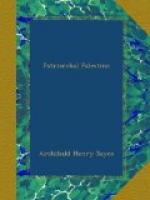A sarcastic account of the misadventures of a military officer in Palestine, which was written in the time of Ramses, is an evidence of the complete occupation of that country by the Egyptians. All parts of Canaan are alluded to in it, and as Dr. Max Mueller has lately pointed out, we find in it for the first time the names of Shechem and Kirjath-Sepher. Similar testimony is borne by a hieroglyphic inscription recently discovered by Dr. Schumacher on the so-called “Stone of Job” in the Hauran. The stone (Sakhrat ’Ayyub) is a monolith westward of the Sea of Galilee, and not far from Tel ’Ashtereh, the ancient Ashtaroth-Karnaim, which was a seat of Egyptian government in the time of Khu-n-Aten. The monolith is adorned with Egyptian sculptures and hieroglyphs. One of the sculptures represents a Pharaoh above whose likeness is the cartouche of Ramses II., while opposite the king, to the left, is the figure of a god who wears the crown of Osiris, but has a full face. Over the god is his name in hieroglyphics. The name, however, is not Egyptian, but seems to be intended for the Canaanite Yakin-Zephon or “Yakin of the North.” It is plain, therefore, that we have here a monument testifying to the rule of Ramses II., but a monument which was erected by natives of the country to a native divinity. For a while the hieroglyphic writing of Egypt had taken the place formerly occupied by the cuneiform syllabary of Babylonia, and Egyptian culture had succeeded in supplanting that which had come from the East.
The nineteenth dynasty ended even more disastrously than the eighteenth. It is true that the great confederacy of northern and Libyan tribes which attacked Egypt by sea and land in the reign of Meneptah, the son and successor of Ramses II., was successfully repulsed, but the energy of the Egyptian power seemed to exhaust itself in the effort. The throne fell into the hands of usurpers, and the house of Ramses was swept away by civil war and anarchy. The government was seized by a Syrian, Arisu by name, and for a time Egypt was compelled to submit to a foreign yoke. The overthrow of the foreigner and the restoration of the native monarchy was due to the valour of Set-nekht, the founder of the twentieth dynasty and the father of Ramses III.




